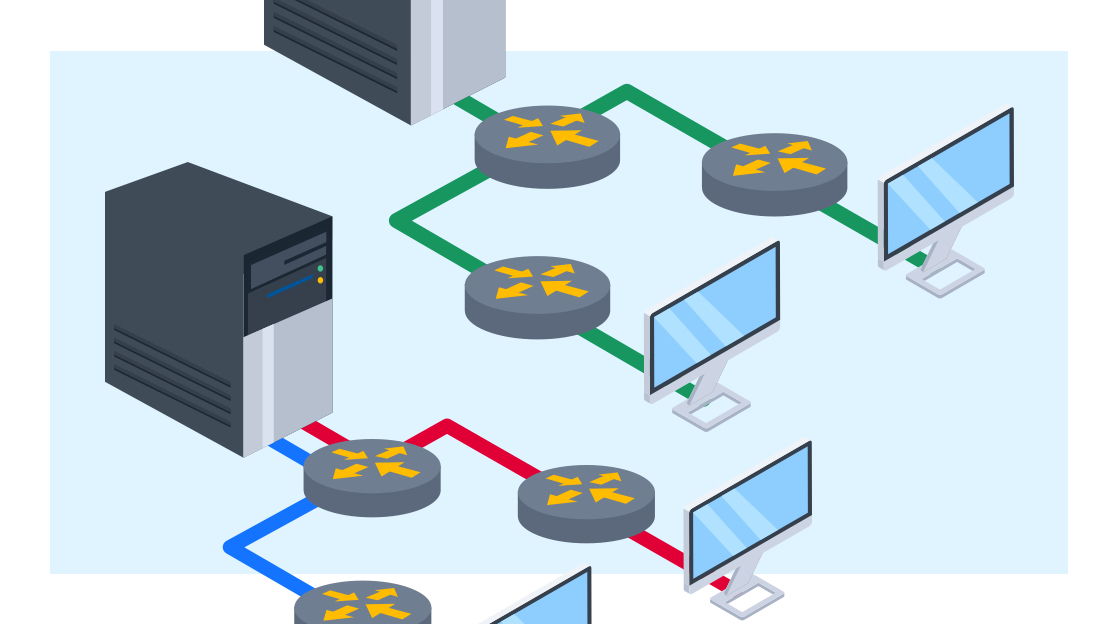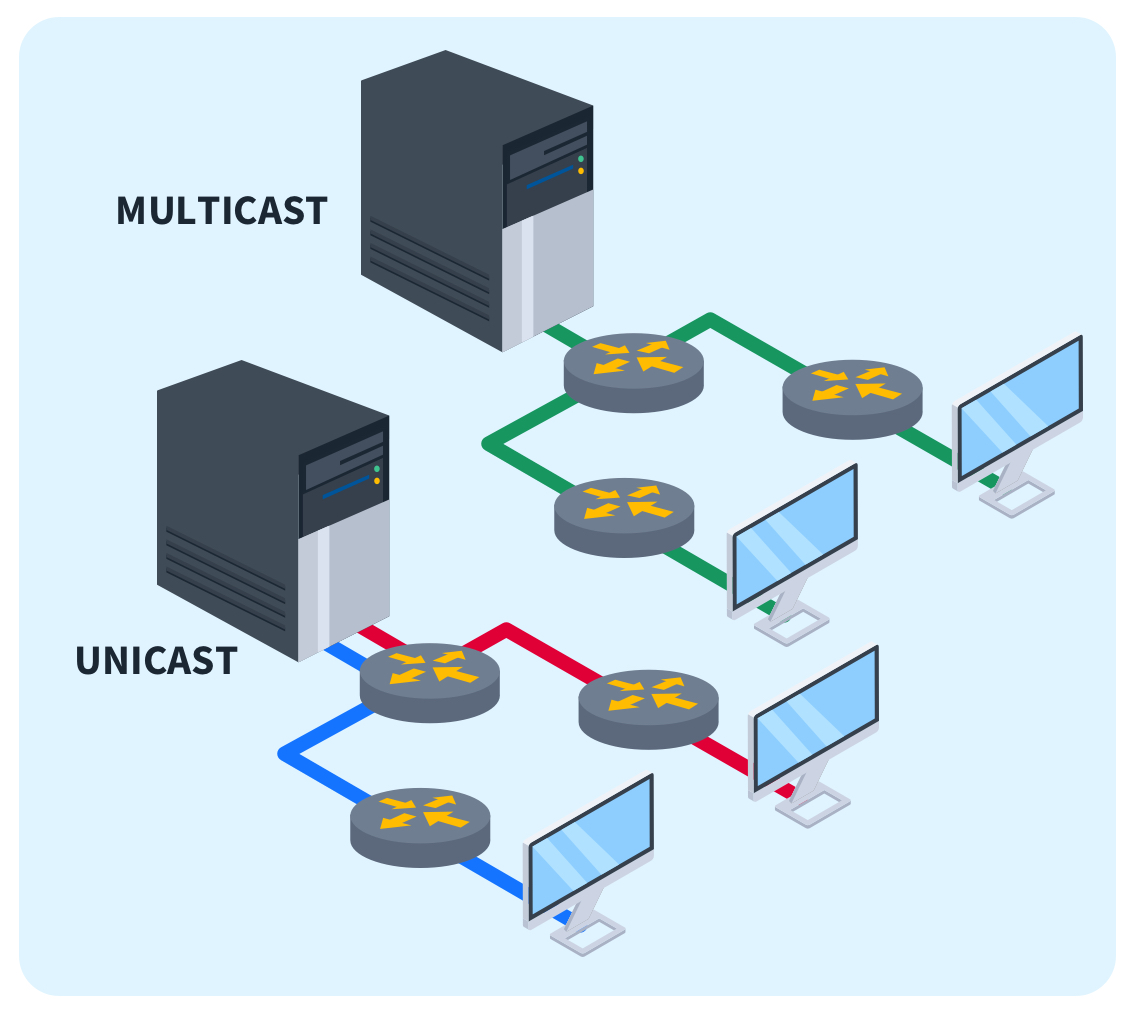Unicast vs Multicast: What are the Differences?

Quick Definition: Unicast is a one-to-one communication where data is sent from a single source to a single receiver, while multicast is a one-to-many or many-to-many communication where data is sent from one or more sources to multiple receivers simultaneously.
If you’re planning a trip to the mall by yourself, you probably climb into your car and then drive there with a single destination. This is a lot like how unicast sends data across a network. It has a specific target that it needs to reach and sends data packets with that recipient (destination) in mind.
If you have a group of 20 people who also wish to do some last-minute shopping at the mall, you are probably not going to hand over your car keys and ask them to go one at a time. That’ll take all day! What you really need is a bus: that is where multicast comes in.
Multicast takes a group of data packets (all part of the same messenger group, or bus in our analogy) and takes them along for the ride. Everyone on the bus wants to go to the mall, but they don’t all need to visit the same stores. All you need to do is drop them off at the entrance, and with their individual shopping adventures in mind, they’ll find their way to their intended destinations.
Next, let's gear up for more interesting facts and differences between unicast and multicast.
What is Unicast Communication?
In our introduction, we described unicast as a private, one-on-one shopping experience that gives data a direct route to its destination. Still, there is more to this delivery method than that. Most Local Area Networks (LANs) are unicast, using protocols like http, smtp, ftp via the TCP protocol.

Point-to-point: Like driving your car directly to a store, unicast is a straight shot from your computer to another device on the network. There are no unnecessary stops – it's a point-to-point journey.
Addressing: In your car, the GPS needs an exact address to reach your destination. In unicast, every data packet has a specific "address" on it, telling the network exactly where to deliver it.
Reliability: If there's a hiccup on the road – maybe a traffic jam or a wrong turn – you've got options. You can pick another route or wait it out. Unicast communication behaves much the same; it verifies that each packet arrives safely and will resend any that get lost in "traffic."
Resource efficiency: Taking your car to the mall means that you use fuel only for your own trip. With unicast, the network's resources are used solely for sending packets on your exclusive data trip, so you don’t waste resources on anyone else's journey.
Ordering: Imagine shopping with a list and picking up your items in a specific order. Unicast packets also arrive in a particular sequence so the recipient can reconstruct the original message, ensuring your data "shopping" is successful and nothing is forgotten.
Unicast is like taking your car for a tailor-made trip, with a specific destination, a dedicated route, and the assurance that your shopping will be a personal and orderly affair.
It's networking's answer to a focused and efficient outing, ensuring that what you send out into the digital world reaches the right device, just as you would ensure every item on your shopping list makes it to the checkout.
This means that unicast works really well in multiple one-to-one communication scenarios like:
Transferring files between two computers
Loading a website on a client device
Streaming media between devices
Gaming traffic between a player and a server
VoIP calls connecting two parties
What is Multicast Communication?
Another way of sending data is with multicast. Corporate and enterprise networks sometimes use multicast for specific applications like video conferencing or proprietary software that needs group messaging. Back to our earlier example, instead of everyone driving separately, a shuttle service is ready to take multiple people to their destination simultaneously. This is multicast communication: a one-to-many service.
Key characteristics of multicast communication:
Group communication: The shuttle service doesn't send a separate bus for each group of shoppers; it sends one that all groups can hop onto when needed. Multicast sends a single stream of data that's replicated across the network to reach all the recipients who are interested in the data, like a shuttle making multiple stops.
Addressing: When shoppers get on the shuttle, they tell the driver where they're headed, allowing them to reach the right destination. In multicast, devices use special group addresses to "tell" the network which data stream they want to catch, helping them join the right "ride."
Efficiency: With multicast, the idea is to carpool data packets to save on bandwidth. Instead of sending individual packets to each device on a network, multicast sends out one packet stream, and the network makes copies only when necessary – much like a shuttle that goes past the same stop again when it sees more passengers.
Reliability: If a few shoppers miss the shuttle, the stores still continue to sell products; it's not a big deal, and they can catch the next one. This is how multicast handles data – it's more about getting the word out efficiently than ensuring every single shopper gets on the first shuttle. It's perfect for live broadcasts where missing a few seconds of a show or stream isn't a deal-breaker.
Multicast is well-suited for one-to-many applications that require high efficiency but can tolerate some packet loss, such as:
Streaming video/audio to many viewers
Push media to news outlets
Database replication between servers
Announcements on enterprise networks
Software updates to clients
Large data transfers to distributed branches
The main downside of multicast is the lack of reliability mechanisms and ordered delivery guarantees. The multicast shuttle is great for getting lots of people to their destination without much wait, but it doesn't guarantee that everyone will arrive in the same order they got on or that they'll all have a seat.
This is the trade-off with multicast: it prioritizes getting the message out to as many people as possible rather than the precision of who gets what and when.
Multicast uses IP addresses ranging from 224.0.0.0 to 239.255.255.255, a block set aside just for groups. Devices use IGMP to raise their hand and say, "Hey, I'm interested in this multicast stream," much like you'd flag down the shuttle driver by joining a group heading to the same destination.
Comparing Unicast vs Multicast
Let's recap the key differences between unicast and multicast:
Unicast | Multicast |
Point-to-point transmission | One-to-many group transmission |
Address each device individually | Use group address for multiple devices |
Reliable delivery | No reliability mechanisms |
Efficient for one recipient | Efficient for many recipients |
Guaranteed packet ordering | No packet ordering |
Key Takeaways:
Unicast is optimal for one-to-one communication, requiring reliability and packet order.
Multicast is optimal for one-to-many applications focused on efficiency over reliability.
When choosing between unicast and multicast, we must think about things such as:
Number of recipients: Multicast scales better for many receivers
Packet loss tolerance: Unicast if loss is unacceptable
Ordering requirements: Unicast ensures in-order delivery
Traffic volume: Multicast minimizes overall bandwidth
Latency needs: Multicast can have lower latency
Analyze your specific performance, scalability, and reliability needs to determine if unicast or multicast better serves your use case.
Unicast and Multicast Use Cases
Let's explore some common use cases where unicast or multicast is typically the preferred method of communication:
When Unicast Works Best
File transfers: Reliably sending files between two endpoints
VoIP calls: Low latency and reliable packet delivery for good call quality
Client-server connections: Web browsing, mobile apps, database access
Interactive apps: Online games, videoconferencing, trading apps
Site-to-site VPNs: Secure tunnels between two locations
When to Use Multicast Instead
IPTV: Efficiently stream media to many television boxes
Software updates: Simultaneously distribute to many devices
Corporate communications: Broadcasts to all employees
Surveillance video: Stream many cameras to a monitoring center
Cloud replication: Sync data across data centers
Conclusion
Just as knowing when to drive solo or take the shuttle can make your trip to the mall more enjoyable, understanding when to use unicast or multicast can make your network more efficient. Unicast is great for one-to-one communications, while multicast gives your network the ability to broadcast messages on a much larger scale.
When deciding which is best for your network, you’ll need to consider factors like scalability, packet loss, and ordering. You will need to understand the needs of the users on the network and the types of applications they use. The best way to do this is to analyze the requirements of each application and data flow to select the best approach.
Applying these basic networking concepts enables you to maximize performance, ensure reliability, and fully leverage network resources. The needs of modern networks vary greatly, so utilize unicast and multicast where they make the most sense.
Not a CBT Nuggets subscriber? Sign up for a 7-day free trial.
delivered to your inbox.
By submitting this form you agree to receive marketing emails from CBT Nuggets and that you have read, understood and are able to consent to our privacy policy.